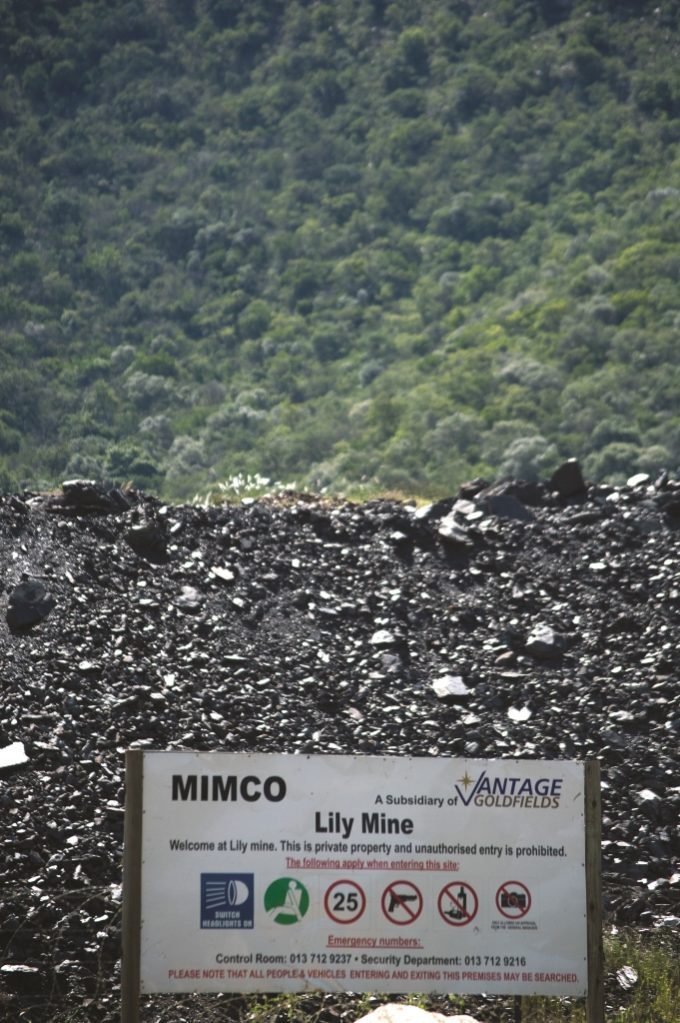The dirt road to Christopher Mazibuko’s house in Louieville, in South Africa’s Mpumalanga province, is rocky, quiet and roamed by skinny goats.
Mazibuko lives in a single room, made of mud, in Louieville, 20 minutes from Lily Mine that took the life of his wife.
On this bright Sunday afternoon, Mazibuko is wearing casual clothes. He sits on his doorstep; with friends sharing a beer – maybe alcohol eases the pain.
It has been a year since the fatal accident at the Vantage Goldfields-owned Lily Mine, near Barberton, where three people – Mazibuko’s wife Pretty Nkambule, Yvonne Mnisi and Solomon Nyarende – were buried in rubble.

Lily Mine began as an oxide open pit operation, in 2000, and became a shallow, underground operation.
It has been a year since we last saw Mazibuko. On that day, soon after the tragedy, he was sitting on a small bench, cradling his seven-month-old daughter and five-year-old son. There was the agony of both hope and despair in their eyes.
Mazibuko will never forget his last day with his wife, one of the three entombed in a steel container, 80 meters underground, after a crown pillar collapsed at the open pit gold mine, on February 5, 2016. He shakes his head and sheds a tear.
On that fateful day, Mazibuko, who also works at the mine, was on leave.
He woke up early to prepare a lunchbox for Nkambule and walked her to the bus station. Little did he know that it would be their last walk together.
“She didn’t want me to make her a bigger lunchbox because she thought she’d return home in the afternoon,” he says.
At 7:30AM the bus came to fetch her and the two waved goodbye for the last time.
Around 8AM Mazibuko received a phone call from Nkambule, telling him that she had arrived safely.
“She asked me if I had seen the R200 ($15) she left for me under the mattress to buy the baby food,” he says.
Ten minutes later, before Mazibuko could go to the shop, a neighbor came rushing to his house telling him that he heard that the mine had collapsed.
Mazibuko didn’t believe it and accompanied the neighbor to the mine with the baby strapped on his back.
What makes it more tragic is that Nkambule was supposed to be on leave, but a colleague asked her to stand in for her.
It was a normal day, around 8AM, 115 people had clocked in. Ten minutes later, to the sounds of machinery grinding into life, Nkambule and the lamp room operators had just handed workers lamps.
“I was in the last container; we were having a casual conversation. Then we heard a loud sound, almost like a tyre bursting,” says Henry Sono, an eyewitness, who worked at the mine for 16 years.
“Everything happened so fast. We saw the ground shaking and sinking before swallowing the container with the three trapped. We watched in fear as there was nothing anyone could have done. I left my glasses, my wallet and everything because I had to run for my life,” says Sono.
“I’m confused because everybody who was underground got out but a container that was on the surface sank, why?… And I think they died the same day and same time. There’s absolutely no way you can be trapped underground for a year and still come out alive.”
Rob Devereux, a business rescue practitioner, says it might still take up to a year to retrieve the container. Rescue operations can’t start until enough money is raised.
“We need R130 million ($9.7 million) to develop a decline shaft and then we’ll assess the situation and decide the best way to retrieve it. We sent cameras down and it is extremely dangerous, especially for the rescuers. So, it might take us about more than eight months to get to the container,” says Devereux.
The three missing workers were all breadwinners. Mazibuko will have to raise the children alone.
“At the moment the children are with their aunt because I can’t take care of them, I can’t even buy myself food. The kids have even forgotten about their mother,” he says.
About 600 workers have been left without jobs since the mine collapsed.
In March last year, Mineral Resources Minister, Mosebenzi Zwane, promised families of the trapped a R200,000 ($15,000) compensation and workers who survived R50,000 ($3,750) each. They claim they’ve seen nothing.

Workers and families are hungry and confused.
“The mine and unions don’t communicate with us. They should tell us what’s happening. I’m slowly losing hope of ever getting my wife out,” says Mazibuko.
The mineworkers last got paid in March last year. Sono has 12 children, he says it’s tough.
“The mine says it doesn’t have money to pay us. We are hungry; we can’t even support our families. They sometimes give us food parcels but it doesn’t happen every month,” says Sono.
At the mine, a young strapping man in a khaki uniform, black boots and a rifle slung over his shoulder, guards the locked gate at the entrance. All the families want is the return of the bodies so they can mourn.
